Abstract
With the growing concern over climate change and energy security, the Government of India expedited enhancing the share of renewable energy (RE) derived from solar, wind and biomass sources within the energy blend. In this paper, a techno-economic and environmental analysis of a microgrid-integrated electric vehicle charging stations fueled by renewable energy is proposed for a typical area in the State of Karnataka, South India. The power transaction with the grid and the sell-back price to the national grid were investigated. Carbon emissions were also assessed, and 128,406 CO2 kg/Yr can be saved in the grid-connected mode. Also, in this work, different scenarios such as injecting active power, reactive power, and active and reactive power, and injecting active and absorbing reactive power to the grid are comprehensively assessed. Out of four types, type 3 (inject real and reactive power) provides significant reduction in power losses by up to 80.99%. The synchrophasor-technology-based monitoring method is adopted in order to enhance the microgrid system’s overall performance. The execution times for different cases with distributed generators (DGs) and electric vehicle charging stations (EVCSs) for conventional systems and micro-phasor measurement units (µPMU) were observed to be 19.07 s and 5.64 s, respectively, which is well accepted in the case of online monitoring.
1. Introduction
The power sector stands as a crucial pillar of any nation’s economic advancement, with a significant role to play in India’s journey towards becoming a developed nation. Ensuring equal accessible affordability and sustainable power has remained a cornerstone principle guiding the sector. Furthermore, the power sector will be instrumental in addressing climate change challenges and fulfilling India’s commitments on the global stage. Over the years, the government has undertaken various initiatives aimed at transforming India from a power-deficit to a power-surplus nation. These efforts include enhancing the proportion of renewable energy within the total capacity blend, establishing a unified national grid, enhancing distribution grids, and attaining electrification for every household universally. As India undergoes economic development, the demand for power is increasing. The demand for electricity in the nation has grown at a Compound Annual Growth Rate (CAGR) of about 4.1% over the last ten years. Based on projections from the 20th EPS Report, this demand is expected to rise at a CAGR of 7.18% during the next five years. By 31 December 2022, the installed capacity of power plants (also known as utilities) had increased to 410,339 MW from just 1362 MW in 1947. Similarly, from roughly 5.1 billion units (BU) in 1950 to 1491.9 BU (including imports) in the fiscal year 2021–2022, there has been a notable growth in the production of electricity []. Since 31 December 2013, the country’s electricity transmission has been made easier by the unification of regional grids into a single national grid via strong inter-regional AC and HVDC linkages. As a result, the nation has seen a consistent decrease in both the energy (MU) not delivered and the peak MW demand not satisfied. During the fiscal year 2021–2022, the peak power deficit was 1.2%, while the energy deficit was only 0.4%. This marginal shortage is attributed to factors other than the availability of generation capacity.
India has made significant progress in transitioning towards renewable energy resources, and installed capacity significantly increased during the fiscal year 2006–2007. Renewable energy sources, including large hydro schemes, have seen their contribution to installed capacity rise from 5.8% in 2006–2007 to 41% as of 31 December 2022. Furthermore, its share in total energy generation rose to 21.54% in 2021–2022 from 1.5% in 2006–2007 [].
The 21st century witnesses a notable surge in global energy demand, driven by economic advancement and population growth. In India, the energy generation landscape mostly relies on fossil fuels, with coal comprising 49.1%, natural gas 6%, nuclear 1.6%, and diesel 0.1%, while renewable energy sources make up 41.6%, as depicted in Figure 1 []. However, this reliance on fossil fuels is depleting the nation’s reserves of coal and natural gas rapidly as it strives to fulfil the escalating electricity needs of an increasing population and swift urbanization. Furthermore, this increasing demand for power exacerbates environmental challenges such as global warming and heightened greenhouse gas emissions. Consequently, promoting non-conventional energy sources such as wind, photovoltaic (PV), biomass, and hydroelectric power emerges as a practical solution to address the surging energy demand while mitigating greenhouse gas emissions [,,,]. Nevertheless, India boasts abundant solar and wind energy resources, as depicted in Figure 2. Beyond manufacturing, researchers are diligently pursuing advancements to harness solar energy more effectively. This includes the development of hybrid energy systems integrating various renewable sources of energy and storage technologies alongside PV panels. Various hybrid configurations have been proposed, such as PV–wind–battery [,], PV–battery–fuel cell [,], PV–wind–fuel cell [], PV–biomass [], and others. Even though many of these hybrid structures are made for stand-alone uses without connection to the electrical grid, integrating them with grid-connected systems presents a viable solution to reduce reliance on storage devices and enhance power supply reliability [,,,,]. Grid-connected renewable energy systems offer numerous advantages, such as harmonic compensation, reactive power supply, load distribution, peak power reduction, regulation of voltage and frequency, and the capability to sustain essential loads during utility disruptions.
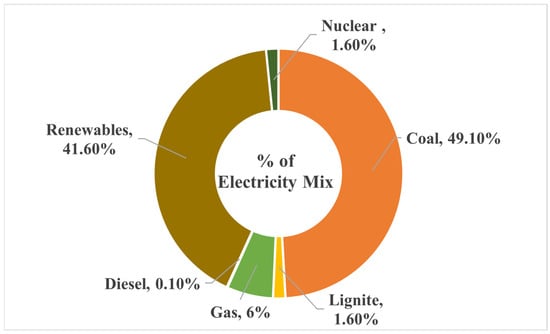
Figure 1.
Proportion of electricity mix in India [].
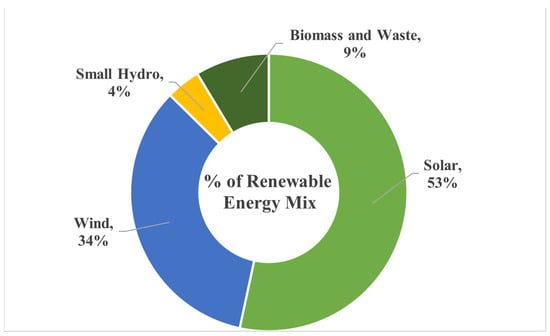
Figure 2.
Proportion of renewable energy mix in India [].
In response to increasing consumer demand and the imperative of addressing climate change, electricity utilities are integrating various renewable energy sources alongside conventional ones. Each type of renewable generation exhibits unique behavior patterns, which the current measuring system struggles to capture adequately due to its slow data-capture rate. SCADA systems are about to be replaced by synchrophasor technology because of their very high sample rates (25–50 samples per second). In the near future, microgrids, energy storage, and electric vehicle charging are expected to become key elements of the power grid. With the growing penetration of renewables, rapid measurement with control action for renewable generation becomes essential. Synchrophasor technology in this application greatly improves power system network architecture, design, and functionality.
Also, the adoption of electric power in the transportation sector using renewable energy resources (RES) represents a promising and relatively novel research frontier. Utilizing RES for power generation in Electric Vehicle Charging Stations (EVCS) could lead to a substantial 433% increase in their utilization by EV users []. As Electric Vehicles (EVs) become more prevalent, accommodating their increasing numbers could be facilitated through renewable distributed generation (DG) []. The focus of numerous investigations in the literature is on Grid-to-Vehicle (G2V) connection, with emerging interest in Vehicle-to-Grid (V2G) connections due to their potential for peak power savings and the enhancement of power system reliability and efficiency [,,]. An experimental study demonstrated the feasibility of a PV–grid-connected EVCS with V2G capabilities, showing its ability to charge EVs while also contributing to grid load management with surplus electricity []. Nevertheless, optimizing the development of EVCS has been explored, considering different electricity generation alternatives including photovoltaic (PV), diesel generators, and batteries, with wind power notably absent as a choice in previous studies [,]. Residential microgrids (MGs) equipped with renewable energy sources (RESs), energy storage, and EV charging capabilities offer a key solution, as RESs help balance energy demand while addressing the issue of emissions []. The optimal system for an EV charging station powered by renewable energy in Korea was explored in []. In [], an overview of electric vehicles and their impacts, various charging modes, and different design approaches for EVCS is presented. In India, various investigations have explored the use of RES in rooftop buildings, mosques, and hospitals, primarily focusing on economic and environmental impacts [,,].
This study aims to develop an Electric Vehicle Charging Station (EVCS) that incorporates renewable energy sources (RES) to effectively manage load demand and lower system costs and emissions. For determining the most optimal feasible scheduling and design of renewable energy technologies, the HOMER simulation program is used in this research []. System inputs are chosen according to market availability references, with design variables including RES size and grid electricity exchange quantities. The proposed model yields optimal system configurations, energy scheduling, component sizing, cost estimates, and emissions. The limitation of multi-objective optimization lies in its inability to offer a singular solution satisfying all criteria []; thus, trade-offs among constraints are inevitable to attain a optimal solution. This study presents a comparison of different scenarios and suggests a suitable solution meeting EVCS designer’s requirements. Also, synchronized phasor measurements are increasingly acknowledged as a promising technology for the development of smart grid applications. Over the past few years, electric utilities worldwide have prioritized the installation of Phasor Measurement Units (PMUs) to continuously monitor power system features. The Gujarat energy transmission corporation limited (GETCO) has taken a pioneering step by installing 118 PMUs at 25 locations—including 4 locations abundant in renewable energy resources—within the Gujarat grid []. In this study, voltage magnitudes are measured from PMUs and compared with the conventional monitoring method.
However, there remains a significant research gap concerning the integration of RES into EVCS, necessitating further studies and investigations in this area. Hence, this study aims to make a key contribution by:
- (i)
- Investigating both hybrid stand-alone and grid-connected systems and analyzing them from technical, economic, and environmental perspectives;
- (ii)
- Comparing various system setups and recommending the most suitable sizes for different hybrid components;
- (iii)
- Examining the incorporation of PV–Wind and PV-only systems that satisfy similar load demands on the grid, and contrasting them with standalone Hybrid Energy Systems (HESs);
- (iv)
- Analyzing how the cost of energy (COE) is affected by grid sell-back prices;
- (v)
- Conducting an analysis of the IEEE 33 bus architecture using micro-pmu (µPMU) with Electric Vehicle Charging Stations (EVCS) and Distributed Generators (DGs).
This study is organized as follows: the suggested technique is explained in Section 2; in Section 3, the outcomes of system configurations are presented; in Section 4, smart monitoring of the IEEE 33 bus architecture incorporated with EVCS and DGs using µPMUs is depicted; and in the final section, the research conclusion is presented and some recommendations are proposed.
2. Materials and Methods
2.1. Mathematical Modeling
2.1.1. PV–Wind Module
An initial investment is necessary for a PV–Wind integrated power system, which yields power generation derived from both PV panels and wind turbines. The mathematical expression for calculating the total power produced by this combined system [] is as follows:
where IT is the solar radiation that strikes the solar array (kW/m2); PPV is PV output power (kW); YPV is PV rated output (kW); fPV is the PV derating factor; IT,STC is the incoming solar radiation in kW/m2 under nominal test conditions (NTC); β is the temperature coefficient (%/°C); solar cell temperature (KC) is defined as °C; and cell temperature (STC) is denoted as KC,STC.
Wind energy is given as:
where ρ represents air density, AW denotes the swept region by the air, and V indicates the wind speed. Solar energy is given as:
where In(t) represents the insulation at time t in kW/m2; AS represents the area of a single PV panel; and η(PV) indicates the overall efficiency of the PV panels. The overall efficiency is expressed as follows:
where PR denotes the performance ratio and K represents the annual average solar radiation acting on the panels.
2.1.2. Converter
The converter efficiency is assumed to be 90% and is connected to the charging assemblies [], given as follows:
where PDC is converter’s output power, η is converter efficiency, and PAC is the converter’s input power.
2.1.3. Battery
The battery bank’s storage capacity is determined as follows:
where V is the voltage and Q constitutes the electric charge.
The energy required for battery charging is determined as follows:
where E denotes the total energy needed to charge the battery, C is the capacity of the battery, ηcharger is the battery charger efficiency, and SOC is the percentage of remaining charge in the battery.
2.1.4. Financial Components
- (a)
- Cost of Energy
The Cost of Energy (COE) represents the charging cost for Electric Vehicles (EVs) per kilowatt hour (kWh) and is defined as follows:
where Cbase and Cvariable represent the basic and variable costs associated with EV charging, respectively. According to peak or off-peak hours, the COE changes.
- (b)
- Net Present Value
Computation of the Net Present Value (NPV) is as follows:
where Rt represents the net input or outflow of cash for a specific period, i denotes the discount rate, and t signifies the project’s duration in years.
2.1.5. CO2 Emissions
The net grid purchases in a grid-linked power plant are determined by HOMER and computed as the total grid purchases minus the total grid sales. The pollution emissions linked to the net grid purchasing are then calculated by the software by multiplying the emission parameter (in g/kWh) divided by the net grid expenditure (in kWh) associated with each pollutant. The Indian electrical grid’s emission factor is reported as 0.968 tCO2/MWh [].
2.2. Selected Site Description
India is the world’s seventh-largest country, covering 3,287,263 square kilometers (1,269,219 square miles), and boasts abundant solar energy resources []. With solar irradiance ranging from 4 to 7 kWh/m2/day and an average of 5 kWh/m2/day, coupled with mean summer temperatures of 25–45 °C and winter temperatures of 5–25 °C, India’s tropical climate within its vast peninsula renders it rich in solar and wind power reserves. Despite this, planning and formulating policies frequently depend on governmental assessments of renewable energy potential []. Based on these estimates, the solar potential is 748.98 GW, utilizing only 3% of accessible wasteland []. In a similar vein, a prudent assessment of wind power potential at 120 m above sea level stands at 695 GW for the country []. Figure 3 depicts the chosen location, indicating its solar and wind capabilities.
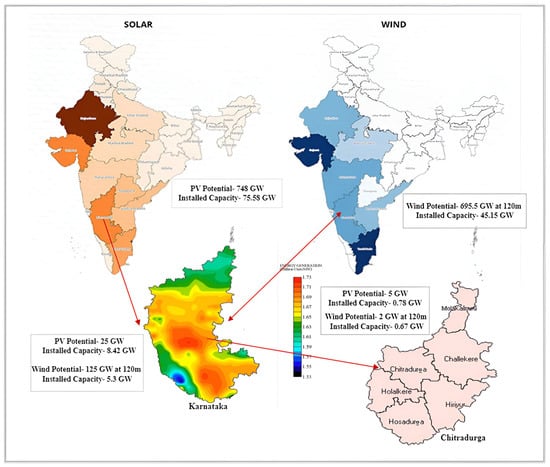
Figure 3.
Selected site.
This study focuses on Chitradurga, Karnataka, India, characterized by a solar irradiance of 5.55 kWh/m2 day and a wind speed of 3.97 m/s. Positioned at 14.23°N, 76.4°E, Chitradurga sits at an average elevation of 737.9 m (2420.93 ft) above sea level, experiencing a subtropical steppe climate classified as BSh by the Köppen–Geiger system. With an annual temperature averaging 27.75 °C (81.95 °F), which is 1.78% higher than India’s average, the region maintains a temperate climate throughout the year due to its elevated position. Moreover, Chitradurga also benefits from consistent wind currents, rendering it conducive for the establishment of both photovoltaic (PV) and wind farms. Notably, the area is home to numerous solar- and wind-power plants, and its hills are adorned with windmills—a prominent feature visible upon entering the city, as depicted in Figure 4.
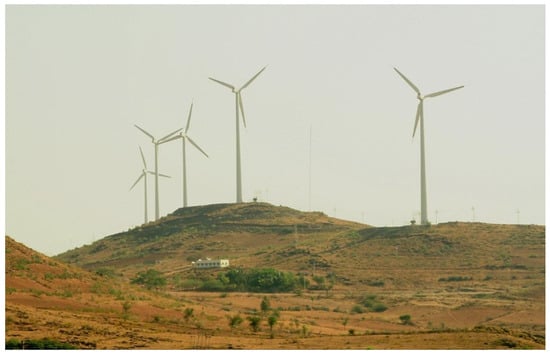
Figure 4.
Windmills at Chitradurga.
The National Renewable Energy Laboratory’s (NREL) monthly mean global radiation chart was used to evaluate the solar system’s potential capacity. Figure 5 illustrates the monthly mean solar global horizontal irradiance (GHI) for the Chitradurga district. The monthly average solar GHI stands at 5.55 kWh/m2/day, with the highest recorded in April (6.81 kWh/m2/day) and the lowest in August (4.77 kWh/m2/day). Regarding wind resources, the average monthly wind speed in the area is typically 3.39 m/s. Figure 6 presents input data for Chitradurga from January to December, depicting the wind speed for each month. Notably, June experiences the highest wind speed at 5.58 m/s, while November witnesses the lowest at 3.02 m/s.
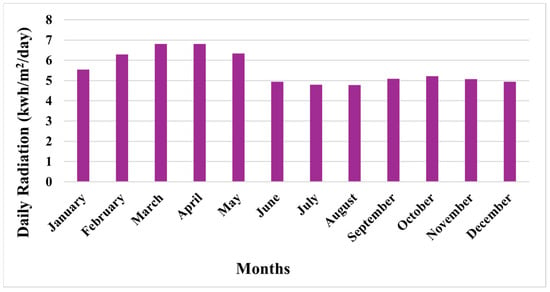
Figure 5.
Monthly average solar global horizontal irradiance in Chitradurga.
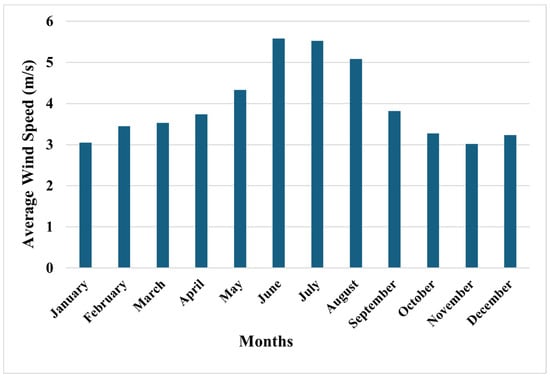
Figure 6.
Monthly average wind speed in Chitradurga.
2.3. System Description
The initial step in simulating a renewable-energy-based EVCS is to design the system architecture. In this scenario, the system design includes energy sources provided by the utility, photovoltaic (PV) panels, wind turbines, batteries, converters, and the load and proposed system architecture, as depicted in Figure 7. This EVCS system’s primary aim is to consistently provide the load with the necessary power. When the grid supply is needed and the PV and wind energy are collectively unable to satisfy the load demands, the grid supply is used. Additionally, an important aspect is that the grid has the capability to purchase surplus energy generated by the PV–wind system through a sell-back policy. The cost of net exported energy is usually less than the average cost of power. According to the Indian central electricity regulatory commission (CERC), the government power tariff is 0.078 $/kWh, whereas the commercial electricity tariff is 0.10 $/kWh. For this study, the highest tariff value of $0.10/kWh is taken into consideration.
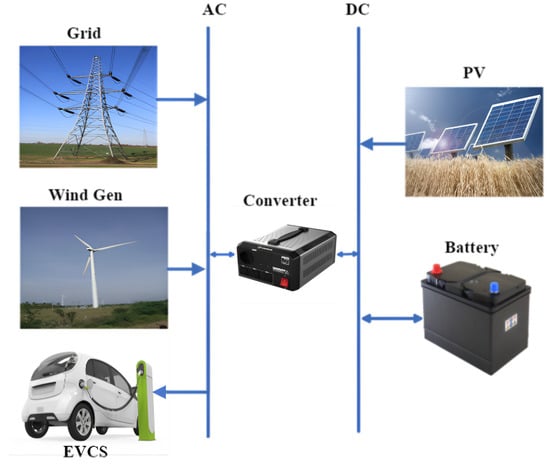
Figure 7.
PV–wind-powered EVCS.
The load curve obtained from the EVCS, which is located in a typical part of Chitradurga, is depicted in Figure 7. It is noted from Figure 8 that charging primarily takes place from 6 AM to 6 PM daily, with lower activity during other hours. This results in an average yearly EV charging station operating frequency of 651 kWh/day. The EV demand pattern is nearly constant throughout the year. Therefore, the proposed PV–wind system could be a possible solution for effectively meeting the demand of 27 kW/day.

Figure 8.
Daily load curve of the proposed EVCS.
3. Results and Discussion
This study assessed the viability of stand-alone Hybrid Energy Systems (HESs) for the designated site. The findings were assessed based on metrics such as the Cost of Energy (COE), Net Present Cost (NPC), capacity of photovoltaic (PV) panels, battery storage, bi-directional converter, surplus energy generation, and Renewable Energy (RE) integration. Additionally, this study explored the integration of HESs with the grid in comparison with standalone systems. This study delves into the responsiveness of different grid purchase scenarios and prices for selling back energy.
Table 1 outlines the technical specifications of the PV–wind powered EVCS, highlighting key components including PV modules, wind generators, converters, and batteries. To conduct techno-economic and environmental assessments, it is imperative to ascertain the quantity of units required as well as associated costs for installation, maintenance, and replacement. Extensive investigations were conducted involving multiple configurations for both standalone and grid-connected systems. Data regarding energy generation from individual components are provided in Table 2 and Table 3. As Table 3 indicates, grid purchases decreased from 8% to 6.64% for the hybrid model. This resulted in reduced operational costs and emissions. Therefore, the PV–wind generator functions to reduce grid purchases. The cost breakdown of the different system components for the grid-tied hybrid PV–wind setup is shown in Figure 9. First and foremost, the PV module requires the largest financial investment, with the battery coming in second.

Table 1.
Size of system components and other features.
Table 1.
Size of system components and other features.
| Component | Size | Capital Cost ($/kW) | Replacement Cost ($/kW) | O&M Cost ($/kW) | Lifetime | Other Parameters |
|---|---|---|---|---|---|---|
| PV | 300 kW 200 kW | 3000 | 2500 | 100 | 25 years | Derating factor, 88% |
| Wind | 167 kW 109 kW | 3000 | 3000 | 70 | 20 years | Hub height, 17 m |
| Converter | 118 kW 126 kW 120 kW 158 kW | 300 | 300 | -- | 15 years | Converter efficiency, 98% Rectifier efficiency, 95% |
| Battery | 3122 kWh 1607 kWh 1710 kWh 1029 kWh | 550 | 550 | 10 | 10 years | Properties per unit voltage, 12 V Maximum capacity, 83.4 Ah |

Table 2.
Comparison of the energy distribution among system components for a stand-alone system.
Table 2.
Comparison of the energy distribution among system components for a stand-alone system.
| Component | PV (kWh/Year) | % of Electricity | PV–wind (kWh/Year) | % of Electricity |
|---|---|---|---|---|
| Production | ||||
| PV | 502,516 | 100 | 498,417 | 90 |
| Wind | -- | -- | 53,221 | 10 |
| Total | 502,516 | 100 | 551,637 | 100 |
| Consumption | ||||
| EV Load | 237,801 | 47.4 | 237,801 | 43.2 |
| Excess Electricity | 264,715 | 52.6 | 313,836 | 56.8 |
| % of Renewable Fraction | 100% | 100% | ||

Table 3.
Comparison of the energy distribution among system components for a grid-connected system.
Table 3.
Comparison of the energy distribution among system components for a grid-connected system.
| Component | PV–Grid (kWh/Year) | % of Electricity | PV–Wind–Grid (kWh/Year) | % of Electricity |
|---|---|---|---|---|
| Production | ||||
| PV | 502,516 | 92 | 497,281 | 87.3 |
| Wind | -- | -- | 34,737 | 6.1 |
| Grid Purchases | 40,790 | 8 | 37,850 | 6.64 |
| Total | 543,306 | 100 | 569,868 | 100 |
| Consumption | ||||
| EV Load | 237,792 | 57.2 | 237,755 | 48.4 |
| Grid Sales | 178,054 | 42.8 | 253,495 | 51.6 |
| Total | 415,846 | 100 | 491,250 | 100 |
| % of Renewable Fraction | 90.2% | 92.3% | ||

Figure 9.
Cost summary of various components.
Table 4 compares standalone and grid-connected systems to give an overview of optimized results for various system setups in a typical area. It is evident that the grid-integrated PV–wind system exhibits the lowest Cost of Energy (COE) and Net Present Cost (NPC) at $0.385/kWh and $2.45 million, respectively, attributed to reduced initial, replacement, maintenance, and operation costs. Figure 10 depicts the monthly electricity generation throughout the year from both the electric grid and the PV–wind energy system, which is critical for sustaining the EVCS. Initially, the charging system prioritizes the utilization of PV and wind energy, only resorting to grid power when necessary. The PV–wind system demonstrates peak electricity generation during June and July, with diminished output during October and November. Figure 11 presents time-series data illustrating the performance of various system components aimed at fulfilling load demands.

Table 4.
Comparison of results between the stand-alone system and proposed PV–wind–grid-powered EV charging station.
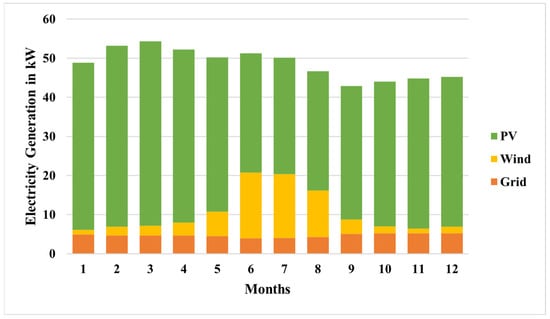
Figure 10.
Electricity generation scenario of the proposed EVCS.
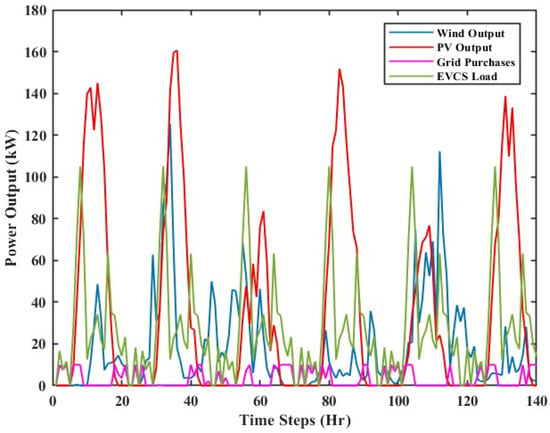
Figure 11.
Time-series data of energy mix in January.
The proposed EVCS offers a lower cost of energy compared to a stand-alone charging station. Although the initial installation costs may be high, the system becomes profitable after a payback period of 6.8 years. Since this payback period is much shorter than the system’s overall lifespan, this clearly demonstrates the long-term financial viability of the system.
3.1. Impacts of Sell-Back Price
The advantages of grid-integrated Hybrid Energy Systems (HESs) largely hinge on government policies concerning the integration of RE into the country’s power grid and the tariffs associated with sell-back options. Currently, there is no governmental policy in place concerning sell-back options for small-scale solar installations (<5 MW) and Hybrid Energy Systems (HESs). Hence, this study undertook an analysis of the potential benefits across various sell-back tariff scenarios for grid-connected HESs. The data depicted in Figure 12 indicate substantial benefits are achievable with a sell-back price of $0.11/kWh. In this scenario, the COE experiences a remarkable decline of over 111% from the baseline scenario (COE = $0.341/kWh). Moreover, escalating the sell-back price to $0.15/kWh results in a 126% reduction in the COE. Nevertheless, very little change in the COE is observed when the tariff is less than the grid purchase price ($0.10/kWh). Therefore, any sell-back price over the grid purchase price could be profitable and could incentivize the development of grid-connected hybrid power plants.
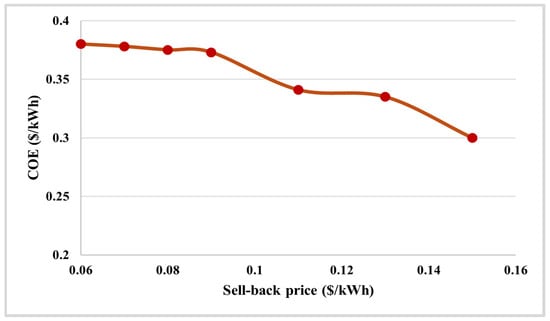
Figure 12.
Impact of the sell-back price on the Cost of Energy (COE).
3.2. Environmental Analysis
India’s environmental policies have significant influence in curtailing carbon emissions []. The PV-based Electric Vehicle Charging Station (EVCS) system offers tangible advantages in mitigating pollutant emissions, notably decreasing levels of carbon dioxide, sulfur dioxide, and nitrogen oxide. Therefore, it demonstrates noteworthy environmental advantages. Figure 13 illustrates the levels of CO2 gas emissions across all scenarios.
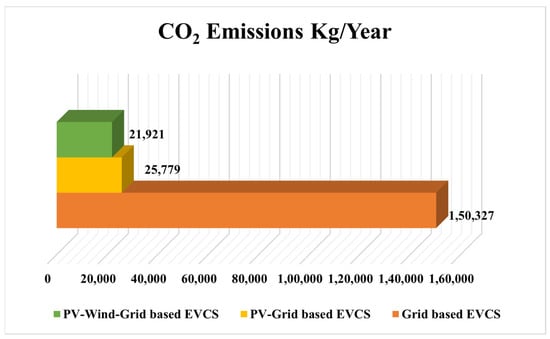
Figure 13.
Comparison of CO2 Emissions in kg/year for different Systems.
4. Smart Monitoring of Distribution Networks Using µPMUs with EVCSs and DGs
The line diagram of the 33-bus test system with EVCS and DG integration and with µPMUs placed at optimal locations is shown in Figure 14. Three EVCSs and type 1, 2, 3, and 4 DGs were used to categorically study the impact of EVCSs and DGs on bus voltage and system losses, as follows:
- Type 1 only inject active power into the system;
- Type 2 only inject reactive power;
- Type 3 inject both active and reactive power;
- Type 4 inject active power but absorb reactive power.
The following scenarios are presented in the following sections:
- Scenario 1: IEEE 33-bus system without EVCSs and without integrating DGs (Base Case);
- Scenario 2: IEEE 33-bus system with EVCS load and without integrating DGs;
- Scenario 3: IEEE 33-bus system with EVCS load and type-1 DGs;
- Scenario 4: IEEE 33-bus system with EVCS load and type-2 DGs;
- Scenario 5: IEEE 33-bus system with EVCS load and type-3 DGs;
- Scenario 6: IEEE 33-bus system with EVCS load and type-4 DGs.
- Scenario 1: IEEE 33-bus system without EVCSs and without integrating DGs (Base Case).
The rated line voltage for all test systems was set at 12.66 kV, with a Base MVA of 100 MVA. The total real and reactive demand on the system amounts to 3.715 MW and 2.3 MVar, respectively. Additionally, the overall active power loss of the system was recorded at 0.19061 MW, while the cumulative reactive loss was 0.14123 MVAr.
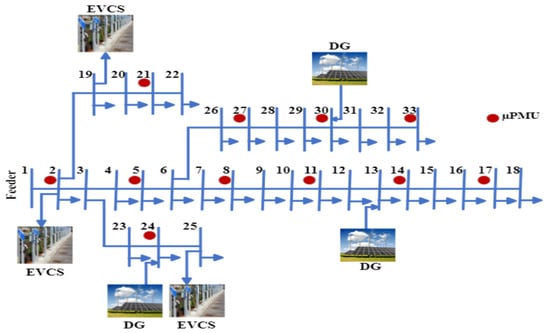
Figure 14.
IEEE 33-bus system with EVCSs and DGs.
- Scenario 2: IEEE 33-bus system with EVCS load and without integrating DGs
Assuming the incorporation of a total of three Electric Vehicle Charging Station (EVCS) loads in the system, a combined power demand of 2925 kW (975 kW per EVCS) is imposed, resulting in a new loading condition for the test system. Consequently, the active power load rose from 3715 kW to 6640 kW. The corresponding performance of the test system is detailed in Table 5. With the increased EVCS load, active power losses escalated to 0.27459 MW from 0.19061 MW, while reactive power losses increased to 0.19431 MVar from 0.14123 MVar.

Table 5.
Performance of IEEE-33 bus system with EVCSs at optimal locations without integrating DGs.
- Scenario 3: IEEE 33-bus system with EVCS load and type-1 DGs
The line diagram of the 33-bus system with integration of EVCSs and DGs is shown in Figure 14. The integration of three EVCSs at optimal locations in the test system (buses 2, 19, and 25) was assumed with active power. Installing multiple DGs in a power system significantly impacts both the system’s voltage profile and its voltage stability. Table 6 shows the voltage magnitudes measured from the forward/backward sweep power flow algorithm, and Table 7 shows the voltage magnitudes obtained from PMUs placed at optimal locations []. From Table 7, it is evident that there was significant improvement in the observability of voltage magnitudes from the PMUs. By integrating DGs, there was an improvement in the voltages of all nodes to some extent, as shown in Figure 15.

Table 6.
Voltage magnitudes obtained from the forward/backward sweep algorithm.
Table 6.
Voltage magnitudes obtained from the forward/backward sweep algorithm.
| Type 1 | Voltage Magnitude (p.u) by Injecting Only Active Power | ||||||
|---|---|---|---|---|---|---|---|
| Bus No. | Base Case | 1 EVCS 975 kW at Bus 2 | 2 EVCSs 975 kW at Buses 2 and 19 | 3 EVCSs 975 kW at Buses 2, 19, and 25 | 1 DG with 2589.6 kW at Bus 6 | 2 DGs with 1898.7 kW at Bus 6 and 649.9 kW at Bus 14 | 3 DGs with 790 kW at Bus 13, 1070 kW at Bus 24, and 1010 kW at Bus 30 |
| 2 | 1 | 0.9994 | 0.9989 | 0.9983 | 0.9998 | 0.9998 | 1 |
| 5 | 0.9760 | 0.9754 | 0.9748 | 0.9709 | 0.9880 | 0.988 | 0.9874 |
| 8 | 0.9405 | 0.9399 | 0.9392 | 0.9351 | 0.9670 | 0.9751 | 0.9724 |
| 11 | 0.9274 | 0.9268 | 0.9262 | 0.9221 | 0.9543 | 0.9723 | 0.9716 |
| 14 | 0.9175 | 0.9169 | 0.9163 | 0.9121 | 0.9447 | 0.9729 | 0.9716 |
| 17 | 0.9127 | 0.9121 | 0.9114 | 0.9072 | 0.94 | 0.9683 | 0.9670 |
| 21 | 0.9952 | 0.9946 | 0.9930 | 0.9924 | 0.9940 | 0.9940 | 0.9942 |
| 24 | 0.9756 | 0.9750 | 0.9745 | 0.9616 | 0.9719 | 0.9718 | 0.9827 |
| 27 | 0.9531 | 0.9525 | 0.9519 | 0.9478 | 0.9793 | 0.9792 | 0.9780 |
| 30 | 0.9300 | 0.9294 | 0.9287 | 0.9246 | 0.9568 | 0.9567 | 0.9711 |
| 33 | 0.9246 | 0.9240 | 0.9234 | 0.9192 | 0.9516 | 0.9515 | 0.9660 |

Table 7.
Voltage magnitudes obtained from the PMUs.
Table 7.
Voltage magnitudes obtained from the PMUs.
| Type 1 | Voltage Magnitude (p.u) by Injecting Only Active Power | ||||||
|---|---|---|---|---|---|---|---|
| Bus No. | Base Case | 1 EVCS 975 kW at Bus 2 | 2 EVCSs 975 kW at Bus 2 and 19 | 3 EVCSs 975 kW at Buses 2, 19, and 25 | 1 DG with 2589.6 kW at Bus 6 | 2 DGs with 1898.7 kW at Bus 6 and 649.9 kW at Bus 14 | 3 DGs with 790 kW at Bus 13, 1070 kW at Bus 24, and 1010 kW at Bus 30 |
| 2 | 0.9973 | 0.9997 | 0.9962 | 0.9956 | 0.9976 | 0.99976 | 0.9983 |
| 5 | 0.9759 | 0.9753 | 0.9748 | 0.9715 | 0.995 | 0.995 | 0.9959 |
| 8 | 0.945 | 0.9445 | 0.9439 | 0.9407 | 0.9846 | 0.9954 | 0.992 |
| 11 | 0.9339 | 0.9334 | 0.9328 | 0.9297 | 0.973 | 0.9956 | 0.9949 |
| 14 | 0.9255 | 0.925 | 0.9244 | 0.9213 | 0.9642 | 1 | 0.0997 |
| 17 | 0.9214 | 0.9209 | 0.9204 | 0.9172 | 0.96 | 0.9956 | 0.9935 |
| 21 | 0.9925 | 0.992 | 0.9904 | 0.9899 | 0.9919 | 0.9919 | 0.9925 |
| 24 | 0.9748 | 0.9743 | 0.9737 | 0.9626 | 0.975 | 0.975 | 1 |
| 27 | 0.9559 | 0.9553 | 0.9548 | 0.9516 | 0.9959 | 0.9959 | 0.9945 |
| 30 | 0.9358 | 0.9353 | 0.9347 | 0.9316 | 0.975 | 0.975 | 1 |
| 33 | 0.9312 | 0.9307 | 0.9301 | 0.927 | 0.9702 | 0.9702 | 0.9951 |
- Type 1: Injecting only active power.
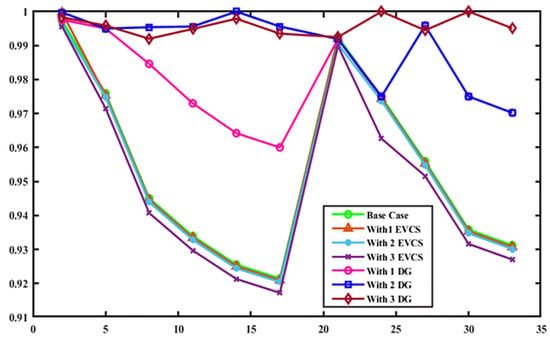
Figure 15.
IEEE 33-bus system voltage profile (p.u) by injecting only active power.
- Scenario 4: IEEE 33-bus system with EVCS load and type-2 DGs
The integration of three EVCSs was assumed with type-2 DG connection. When placing multiple DGs with reactive power injection, the total power losses were reduced by 19.68%, 23.03%, and 24.58%, respectively. The voltage magnitudes obtained from the forward/backward sweep power flow algorithm and µPMUs are shown in Table 8 and Table 9. From Table 8, it is prominent that the voltage profile was improved significantly from PMU measurements when compared to the forward/backward sweep method, as shown in Figure 16.

Table 8.
Voltage magnitudes obtained from the forward/backward sweep algorithm.
Table 8.
Voltage magnitudes obtained from the forward/backward sweep algorithm.
| Type 2 | Voltage Magnitude (p.u) by Injecting Only Active Power | ||||||
|---|---|---|---|---|---|---|---|
| Bus No. | Base Case | 1 EVCS 975 kW at Bus 2 | 2 EVCSs 975 kW at Bus 2 and 19 | 3 EVCSs 975 kW at Buses 2, 19, and 25 | 1 DG with 2589.6 kW at Bus 6 | 2 DGs with 1898.7 kW at Bus 6 and 649.9 kW at Bus 14 | 3 DGs with 790 kW at Bus 13, 1070 kW at Bus 24, and 1010 kW at Bus 30 |
| 2 | 1 | 0.9994 | 0.9989 | 0.9983 | 0.9987 | 0.9987 | 0.9989 |
| 5 | 0.9760 | 0.9754 | 0.9748 | 0.9709 | 0.9766 | 0.9777 | 0.9783 |
| 8 | 0.9405 | 0.9399 | 0.9392 | 0.9351 | 0.9471 | 0.9547 | 0.9541 |
| 11 | 0.9274 | 0.9268 | 0.9262 | 0.9221 | 0.9342 | 0.9463 | 0.9450 |
| 14 | 0.9175 | 0.9169 | 0.9163 | 0.9121 | 0.9243 | 0.9370 | 0.9383 |
| 17 | 0.9127 | 0.9121 | 0.9114 | 0.9072 | 0.9195 | 0.9322 | 0.9336 |
| 21 | 0.9952 | 0.9946 | 0.9930 | 0.9924 | 0.9928 | 0.9929 | 0.9930 |
| 24 | 0.9756 | 0.9750 | 0.9745 | 0.9616 | 0.9643 | 0.9648 | 0.9690 |
| 27 | 0.9531 | 0.9525 | 0.9519 | 0.9478 | 0.9617 | 0.9637 | 0.9638 |
| 30 | 0.9300 | 0.9294 | 0.9287 | 0.9246 | 0.9543 | 0.9540 | 0.9539 |
| 33 | 0.9246 | 0.9240 | 0.9234 | 0.9192 | 0.9491 | 0.9488 | 0.9487 |

Table 9.
Voltage magnitudes obtained from the PMUs.
Table 9.
Voltage magnitudes obtained from the PMUs.
| Type 2 | Voltage Magnitude (p.u) by Injecting Only Reactive Power | ||||||
|---|---|---|---|---|---|---|---|
| Bus No. | Base Case | 1 EVCS 975 kW at Bus 2 | 2 EVCSs 975 kW at Bus 2 and 19 | 3 EVCSs 975 kW at Buses 2, 19, and 25 | 1 DG with 2589.6 kW at Bus 6 | 2 DGs with 1898.7 kW at Bus 6 and 649.9 kW at Bus 14 | 3 DGs with 790 kW at Bus 13, 1070 kW at Bus 24, and 1010 kW at Bus 30 |
| 2 | 0.9973 | 0.9997 | 0.9962 | 0.9956 | 0.9968 | 0.99972 | 0.9983 |
| 5 | 0.9759 | 0.9753 | 0.9748 | 0.9715 | 0.9853 | 0.9901 | 0.9958 |
| 8 | 0.945 | 0.9445 | 0.9439 | 0.9407 | 0.9667 | 0.9921 | 0.992 |
| 11 | 0.9339 | 0.9334 | 0.9328 | 0.9297 | 0.9553 | 0.9987 | 0.9949 |
| 14 | 0.9255 | 0.925 | 0.9244 | 0.9213 | 0.9467 | 0.9923 | 0.9979 |
| 17 | 0.9214 | 0.9209 | 0.9204 | 0.9172 | 0.9425 | 0.988 | 0.9935 |
| 21 | 0.9925 | 0.992 | 0.9904 | 0.9899 | 0.991 | 0.9914 | 0.9925 |
| 24 | 0.9748 | 0.9743 | 0.9737 | 0.9626 | 0.9698 | 0.9724 | 1 |
| 27 | 0.9559 | 0.9553 | 0.9548 | 0.9516 | 0.9842 | 0.9917 | 0.9945 |
| 30 | 0.9358 | 0.9353 | 0.9347 | 0.9316 | 1 | 1 | 1 |
| 33 | 0.9312 | 0.9307 | 0.9301 | 0.927 | 0.9951 | 0.9951 | 0.9951 |
- Type 1: Injecting only reactive power.
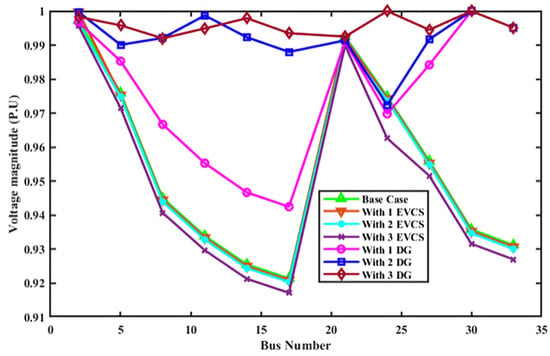
Figure 16.
IEEE 33-bus system voltage profile (p.u) by injecting only reactive power.
- Scenario 5: IEEE 33-bus system with EVCS load and type-3 DGs
The integration of three EVCSs was assumed with type-3 DGs. Placing multiple DGs with active and reactive power injection resulted in the reduction of power losses by 55.44%, 64.44%, and 80.99%, respectively. The voltage magnitudes obtained from the forward/backward sweep method and PMUs are shown in Table 10 and Table 11, respectively.

Table 10.
Voltage magnitude results obtained from the forward/backward sweep algorithm.
Table 10.
Voltage magnitude results obtained from the forward/backward sweep algorithm.
| Type 3 | Voltage Magnitude (p.u) by Injecting Only Active and Reactive Power | ||||||
|---|---|---|---|---|---|---|---|
| Bus No. | Base Case | 1 EVCS 975 kW at Bus 2 | 2 EVCSs 975 kW at Bus 2 and 19 | 3 EVCSs 975 kW at Buses 2, 19, and 25 | 1 DG with 2589.6 kW at Bus 6 | 2 DGs with 1898.7 kW at Bus 6 and 649.9 kW at Bus 14 | 3 DGs with 790 kW at Bus 13, 1070 kW at Bus 24, and 1010 kW at Bus 30 |
| 2 | 1 | 0.9994 | 0.9989 | 0.9983 | 1.0004 | 1.0002 | 1.0006 |
| 5 | 0.9760 | 0.9754 | 0.9748 | 0.9709 | 0.9956 | 0.9945 | 0.9936 |
| 8 | 0.9405 | 0.9399 | 0.9392 | 0.9351 | 0.9826 | 0.9971 | 0.9878 |
| 11 | 0.9274 | 0.9268 | 0.9262 | 0.9221 | 0.9702 | 1.0035 | 0.9892 |
| 14 | 0.9175 | 0.9169 | 0.9163 | 0.9121 | 0.9607 | 0.9944 | 0.9911 |
| 17 | 0.9127 | 0.9121 | 0.9114 | 0.9072 | 0.9561 | 0.9899 | 0.9866 |
| 21 | 0.9952 | 0.9946 | 0.9930 | 0.9924 | 0.9945 | 0.9944 | 0.9947 |
| 24 | 0.9756 | 0.9750 | 0.9745 | 0.9616 | 0.9753 | 0.9745 | 0.9913 |
| 27 | 0.9531 | 0.9525 | 0.9519 | 0.9478 | 0.9947 | 0.9987 | 0.9905 |
| 30 | 0.9300 | 0.9294 | 0.9287 | 0.9246 | 0.9726 | 1.0131 | 0.9933 |
| 33 | 0.9246 | 0.9240 | 0.9234 | 0.9192 | 0.9675 | 0.0082 | 0.9883 |

Table 11.
Voltage magnitude results obtained from the PMUs.
Table 11.
Voltage magnitude results obtained from the PMUs.
| Type 3 | Voltage Magnitude (p.u) by Injecting Only Active and Reactive Power | ||||||
|---|---|---|---|---|---|---|---|
| Bus No. | Base Case | 1 EVCS 975 kW at Bus 2 | 2 EVCSs 975 kW at Bus 2 and 19 | 3 EVCSs 975 kW at Buses 2, 19, and 25 | 1 DG with 2589.6 kW at Bus 6 | 2 DGs with 1898.7 kW at Bus 6 and 649.9 kW at Bus 14 | 3 DGs with 790 kW at Bus 13, 1070 kW at Bus 24, and 1010 kW at Bus 30 |
| 2 | 0.9973 | 0.9997 | 0.9962 | 0.9956 | 0.9976 | 0.9972 | 0.9983 |
| 5 | 0.9759 | 0.9753 | 0.9748 | 0.9715 | 0.995 | 0.9902 | 0.9958 |
| 8 | 0.945 | 0.9445 | 0.9439 | 0.9407 | 0.9846 | 0.9928 | 0.992 |
| 11 | 0.9339 | 0.9334 | 0.9328 | 0.9297 | 0.973 | 1 | 0.9949 |
| 14 | 0.9255 | 0.925 | 0.9244 | 0.9213 | 0.9642 | 0.991 | 0.9979 |
| 17 | 0.9214 | 0.9209 | 0.9204 | 0.9172 | 0.96 | 0.9866 | 0.9935 |
| 21 | 0.9925 | 0.992 | 0.9904 | 0.9899 | 0.9919 | 0.9915 | 0.9925 |
| 24 | 0.9748 | 0.9743 | 0.9737 | 0.9626 | 0.975 | 0.9724 | 1 |
| 27 | 0.9559 | 0.9553 | 0.9548 | 0.9516 | 0.9959 | 0.992 | 0.9945 |
| 30 | 0.9358 | 0.9353 | 0.9347 | 0.9316 | 0.975 | 1 | 1 |
| 33 | 0.9312 | 0.9307 | 0.9301 | 0.927 | 0.9702 | 0.9951 | 0.9951 |
Figure 17 shows the minimum and maximum voltages at different buses before and after placing type-3 DGs, showing that the voltage profile was improved considerably by connecting three DGs.
- Type 3: Injecting active and reactive power.
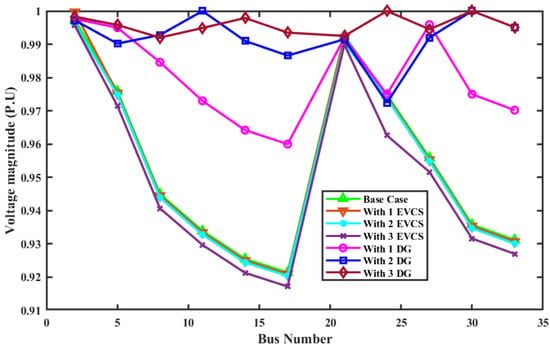
Figure 17.
IEEE 33-bus system voltage profile (p.u) by injecting active and reactive power.
- Scenario 6: IEEE 33-bus system with EVCS load and type-4 DGs
The integration of three EVCSs was assumed with type-4 DGs. Placing multiple DGs with active power injection and reactive power absorption resulted in the reduction of total power losses by 22.8%, 34.38%, and 43.53%, respectively. The voltage magnitudes obtained from the forward/backward sweep power flow algorithm and the PMUs are shown in Table 12 and Table 13, respectively, and the voltage profile is shown in Figure 18.

Table 12.
Voltage magnitude results obtained from the forward/backward sweep algorithm.

Table 13.
Voltage magnitude results obtained from the PMUs.
- Type 4: Injecting only reactive power.
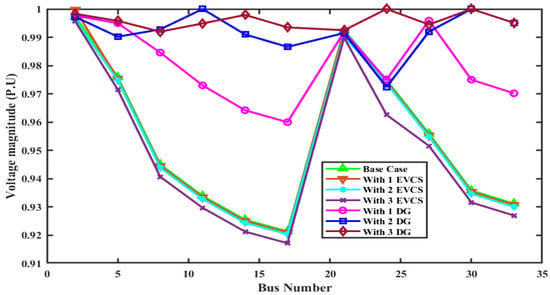
Figure 18.
IEEE 33-bus system voltage profile (p.u) by injecting active and absorbing reactive power.
The technical specifications of the computer used for the simulations are an Intel 2.4 GHz CPU with 16 GB RAM. The time taken to obtain the PMU measurements from the conventional method is shown in Table 14.
Incorporating DGs into the distribution power system decreased system overloading, offering increased released capacity and enhanced voltage regulation. Table 15 shows the total power losses obtained by integrating different types of DGs and the percentages of loss reduction. The active power losses and reactive power losses for all the scenarios are shown in Figure 19 and Figure 20, respectively.

Table 14.
Comparison of execution times based on integrating different types of DGs.
Table 14.
Comparison of execution times based on integrating different types of DGs.
| Execution Time Using Forward/Backward Algorithm (seconds) | Execution Time Using µPMUs (seconds) | |
|---|---|---|
| Base Case | 19.59 | 5.93 |
| 1 EVCS | 19.64 | 5.64 |
| 2 EVCS | 19.75 | 5.65 |
| 3 EVCS | 19.98 | 5.78 |
| Type 1 | ||
| 1 DG | 19.76 | 5.68 |
| 2 DGs | 19.95 | 5.80 |
| 3 DGs | 19.98 | 6.25 |
| Type 2 | ||
| 1 DG | 19.79 | 5.68 |
| 2 DGs | 19.88 | 5.80 |
| 3 DGs | 19.89 | 6.00 |
| Type 3 | ||
| 1 DG | 19.82 | 5.89 |
| 2 DGs | 19.88 | 5.80 |
| 3 DGs | 19.92 | 6.06 |
| Type 4 | ||
| 1 DG | 19.07 | 5.95 |
| 2 DGs | 20.07 | 6.03 |
| 3 DGs | 21.22 | 6.12 |

Table 15.
Comparison of total power losses by integrating different types of DGs.
Table 15.
Comparison of total power losses by integrating different types of DGs.
| Installed Capacity of DG | Total Active Power Loss (MW) | Total Reactive Power Loss (MW) | Loss Reduction in % | |
|---|---|---|---|---|
| Base Case | ---- | 0.19061 | 0.14123 | ---- |
| 1 EVCS | 975 kW at bus 2 | 0.19578 | 0.14393 | |
| 2 EVCSs | 975 kW at bus 2 and bus 19 | 0.20382 | 0.14884 | |
| 3 EVCSs | 975 kW at bus 2, bus 19, and bus 25 | 0.27459 | 0.19431 | |
| Type 1 | ||||
| 1 DG | 2589.6 kW at bus 6 | 0.16078 | 0.11992 | 41.44% |
| 2 DGs | 1898.7 kW at bus 6 649.9 kW at bus 14 | 0.14121 | 0.10256 | 48.57% |
| 3 DGs | 790 kW at bus 13 1070 kW at bus 24 1010 kW at bus 30 | 0.09893 | 0.07198 | 63.97% |
| Type 2 | ||||
| 1 DG | 1230 kvar at bus 30 | 0.22053 | 0.15477 | 19.68% |
| 2 DGs | 430 kvar at bus 12 1040 kvar at bus 30 | 0.21135 | 0.14741 | 23.03% |
| 3 DGs | 360 kvar at bus 13 510 kvar at bus 24 1020 kvar at bus 30 | 0.20708 | 0.14479 | 24.58% |
| Type 3 | ||||
| 1 DG | 2558.2 kW/1761.1 kvar at bus 6 | 0.12233 | 0.092437 | 55.44% |
| 2 DGs | 1171.2 kW/188.1 kvar at bus 11 1095.4 kW/1667.0 kvar at bus 30 | 0.09763 | 0.06890 | 64.44% |
| 3 DGs | 537.8 kW/597.3 kvar at bus 13 1058.9 kW/832.9 kvar at bus 24 967.7 kW/832.6 kvar at bus 30 | 0.05219 | 0.03769 | 80.99% |
| Type 4 | ||||
| 1 DG | 1095 kW/−235 kvar at bus 13 | 0.211983 | 0.14876 | 22.8% |
| 2 DGs | 1171.2 kW/−188.1 kvar at bus 11 1095.4 kW/−266.0 kvar at bus 30 | 0.180175 | 0.12967 | 34.38% |
| 3 DGs | 663.07 kW/−217.9 kvar at bus 13 1400 kW/−460.16 kvar at bus 24 717.08 kW/ −235.69 kvar at bus 30 | 0.15506 | 0.11258 | 43.53% |

Figure 19.
Active power losses for all scenarios.
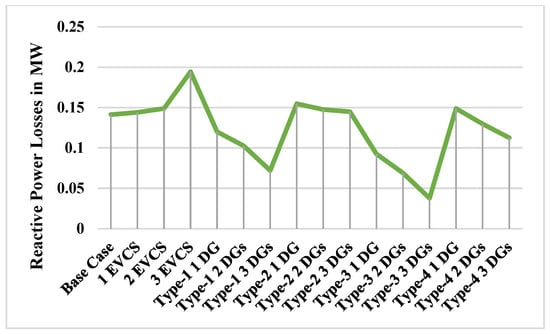
Figure 20.
Reactive power losses for all scenarios.
5. Conclusions
This paper developed a PV–wind based Electric Vehicle Charging Station (EVCS) for Karnataka, addressing the significant contributions of the transport and power sectors to global carbon emissions. This study aimed to optimize microgrid-integrated EVCSs using PV–wind systems, revealing an 85% reduction in emissions and a notable decrease in the cost of energy. CO2 emissions from the hybrid PV–wind EVCS were significantly lower, reducing from 150,327 kg/yr to 21,921 kg/yr compared to grid-only systems. As renewable energy sources like PV and wind are highly intermittent in nature, the existing measurement system struggles to capture the dynamics of the system because of a slow data rate. However, synchrophasor technology, with a high sampling rate, offers a solution for dynamic monitoring and is poised to replace SCADA systems. Microgrids, energy storage, and EV charging are expected to be key elements in future power grids. Among the four types of power injection studied, injecting both real and reactive power (type 3) reduced power losses by 80.99%. Simulations on a 2.4 GHz processor with 16 GB RAM showed that µPMUs significantly outperformed conventional monitoring, with execution times of 5.64 s versus 19.07 s. This method enhances situational awareness for smart grid applications, and future work could explore network observability in case of µPMU failure.
Author Contributions
D.B. conceptualized the research, evaluated the results, and drafted the manuscript; S.H. supervised the work, and reviewed and edited the final manuscript; S.M. contributed to the interpretation of the results. All authors have read and agreed to the published version of the manuscript.
Funding
This research received no external funding.
Data Availability Statement
The raw data supporting the conclusions of this article will be made available by the authors on request.
Conflicts of Interest
The authors declare no conflicts of interest.
Abbreviations
| RE | Renewable Energy |
| µPMU | Micro Phasor Measurement Unit |
| EVCS | Electric Vehicle Charging Station |
| CAGR | Compound Annual Growth Rate |
| BU | Billion Units |
| MU | Million Units |
| DG | Distributed Generator |
| PV | Photovoltaic |
| V2G | Vehicle to Grid |
| COE | Cost of Energy |
| NPV | Net Present Value |
References
- Electric Power Survey Report 2022. Available online: https://cea.nic.in/wpcontent/uploads/ps___lf/2022/11/20th_EPS____Report___Final___16.11.2022.pdf (accessed on 16 November 2022).
- Final Report on National Electricity Plan 2022–2032. Available online: https://mnre.gov.in/policies-and-regulations/policies-and-guidelines/centre (accessed on 12 March 2024).
- Report on All India Installed Capacity. Available online: https://cea.nic.in/wp-content/uploads/installed/2023/05/IC_May_2023.pdf (accessed on 31 May 2023).
- Mandal, S.; Das, B.K.; Hoque, N. Optimum sizing of a stand-alone hybrid energy system for rural electrification in Bangladesh. J. Clean. Prod. 2018, 200, 12–27. [Google Scholar] [CrossRef]
- Akram, F.; Asghar, F.; Majeed, M.A.; Amjad, W.; Manzoor, M.O.; Munir, A. Techno-economic optimization analysis of stand-alone renewable energy system for remote areas. Sustain. Energy Technol. Assess. 2020, 38, 100673. [Google Scholar] [CrossRef]
- Kiwan, S.; Al-Nimr, M.; Salim, I. A hybrid solar chimney/photovoltaic thermal system for direct electric power production and water distillation. Sustain. Energy Technol. Assess. 2020, 38, 100680. [Google Scholar] [CrossRef]
- Carvajal-Romo, G.; Valderrama-Mendoza, M.; Rodríguez-Urrego, D.; Rodríguez-Urrego, L. Assessment of solar and wind energy potential in La Guajira, Colombia: Current status, and future prospects. Sustain. Energy Technol. Assess. 2019, 36, 100531. [Google Scholar] [CrossRef]
- Nandi, S.K.; Ghosh, H.R. A wind–PV-battery hybrid power system at Sitakunda in Bangladesh. Energy Policy 2009, 37, 3659–3664. [Google Scholar] [CrossRef]
- Darus, Z.; Hashim, N.A.; Manan, S.A.; Rahman, M.A.; Maulud, K.A.; Karim, O.A. The development of hybrid integrated renewable energy system (wind and solar) for sustainable living at Perhentian Island, Malaysia. Eur. J. Soc. Sci. 2009, 9, 557–563. [Google Scholar]
- Das, H.S.; Tan, C.W.; Yatim, A.; Lau, K.Y. Feasibility analysis of hybrid photovoltaic/battery/fuel cell energy system for an indigenous residence in East Malaysia. Renew. Sustain. Energy Rev. 2017, 76, 1332–1347. [Google Scholar] [CrossRef]
- Isa, N.M.; Das, H.S.; Tan, C.W.; Yatim, A.; Lau, K.Y. A techno-economic assessment of a combined heat and power photovoltaic/fuel cell/battery energy system in Malaysia hospital. Energy 2016, 112, 75–90. [Google Scholar] [CrossRef]
- Eid, A. Utility integration of PV-wind-fuel cell hybrid distributed generation systems under variable load demands. Int. J. Electr. Power Energy Syst. 2014, 62, 689–699. [Google Scholar] [CrossRef]
- Heydari, A.; Askarzadeh, A. Techno-economic analysis of a PV/biomass/fuel cell energy system considering different fuel cell system initial capital costs. Sol. Energy 2016, 133, 409–420. [Google Scholar] [CrossRef]
- Bukar, A.L.; Tan, C.W. A review on stand-alone photovoltaic-wind energy system with fuel cell: System optimization and energy management strategy. J. Clean. Prod. 2019, 221, 73–88. [Google Scholar] [CrossRef]
- Tan, Q.; Mei, S.; Ye, Q.; Ding, Y.; Zhang, Y. Optimization model of a combined wind–PV–thermal dispatching system under carbon emissions trading in China. J. Clean. Prod. 2019, 225, 391–404. [Google Scholar] [CrossRef]
- Murugaperumal, K.; Srinivasn, S.; Prasad, G.S. Optimum design of hybrid renewable energy system through load forecasting and different operating strategies for rural electrification. Sustain. Energy Technol. Assess. 2019, 37, 100613. [Google Scholar] [CrossRef]
- Raghuwanshi, S.S.; Arya, R. Reliability evaluation of stand-alone hybrid photovoltaic energy system for rural healthcare centre. Sustain. Energy Technol. Assess. 2020, 37, 100624. [Google Scholar] [CrossRef]
- Mhandu, S.R.; Longe, O.M. Techno-Economic Analysis of Hybrid PV-Wind-Diesel-Battery Standalone and Grid-Connected Microgrid for Rural Electrification in Zimbabwe. In Proceedings of the 2022 IEEE Nigeria 4th International Conference on Disruptive Technologies for Sustainable Development (NIGERCON), Lagos, Nigeria, 5–7 April 2022. [Google Scholar]
- Nienhueser, I.A.; Qiu, Y. Economic and environmental impacts of providing renewable energy for electric vehicle charging—A choice experiment study. Appl. Energy 2016, 180, 256–268. [Google Scholar] [CrossRef]
- Shaaban, M.F.; El-Saadany, E.F. Accommodating high penetrations of PEVs and renewable DG considering uncertainties in distribution systems. IEEE Trans. Power Syst. 2013, 29, 259–270. [Google Scholar] [CrossRef]
- Rahman, M.M.; Al-Ammar, E.A.; Das, H.S.; Ko, W. Technical Assessment of Plug-In Hybrid Electric Vehicle Charging Scheduling for Peak Reduction. In Proceedings of the 2019 10th International Renewable Energy Congress (IREC), Sousse, Tunisia, 26–28 March 2019. [Google Scholar]
- Shafiq, S.; Al-Awami, A.T. Reliability and economic assessment of renewable micro-grid with V2G electric vehicles coordination. In Proceedings of the 2015 IEEE Jordan Conference on Applied Electrical Engineering and Computing Technologies (AEECT), Amman, Jordan, 3–5 November 2015. [Google Scholar]
- Habib, S.; Kamran, M.; Rashid, U. Impact analysis of vehicleto- grid technology and charging strategies of electric vehicles on distribution networks—A review. J. Power Sources 2015, 277, 205–214. [Google Scholar] [CrossRef]
- Fathabadi, H. Novel solar powered electric vehicle charging station with the capability of vehicle-to-grid. Sol. Energy 2017, 142, 136–143. [Google Scholar] [CrossRef]
- Hafez, O.; Bhattacharya, K. Optimal design of electric vehicle charging stations considering various energy resources. Renew. Energy 2017, 107, 576–589. [Google Scholar] [CrossRef]
- Nazari, M.A.; Blazek, V.; Prokop, L.; Misak, S.; Prabaharan, N. Electric vehicle charging by use of renewable energy technologies: A comprehensive and updated review. Comput. Electr. Eng. 2024, 118, 109401. [Google Scholar] [CrossRef]
- Marinescu, C. Progress in the development and implementation of residential EV charging stations based on renewable energy sources. Energies 2022, 16, 179. [Google Scholar] [CrossRef]
- Ihm, J.; Amghar, B.; Chun, S.; Park, H. Optimum design of an electric vehicle charging station using a renewable power generation system in South Korea. Sustainability 2023, 15, 9931. [Google Scholar] [CrossRef]
- Narasipuram, R.P.; Mopidevi, S. A technological overview & design considerations for developing electric vehicle charging stations. J. Energy Storage 2021, 43, 103225. [Google Scholar] [CrossRef]
- Ashraf, I.; Al Sharari, H.; Tariq, M.; Tabish, S. Grid-Assisted Rooftop Solar PV System: A Step toward Green Medina, KSA. Smart Sci. 2018, 7, 130–138. [Google Scholar] [CrossRef]
- Moria, H. Techno-Economic Optimization of Solar/Wind Turbine System for Remote Mosque in Saudi Arabia Highway: Case Study. Int. J. Eng. Res. 2019, 8, 78–84. [Google Scholar] [CrossRef]
- Alghamdi, A.H.S. Technical and Economic Analysis of Solar Energy Application for a Hospital Building in Dammam, Saudi Arabia. Master’s Thesis, Auckland University of Technology, Auckland, New Zealand, 2018. [Google Scholar]
- HOMER Grid. 2020. Available online: https://www.homerenergy.com/products/pro/docs/latest/index.html (accessed on 10 October 2020).
- Koski, J. Defectiveness of weighting method in multicriterion optimization of structures. Commun. Appl. Numer. Methods 1985, 1, 333–337. [Google Scholar] [CrossRef]
- Shah, D.N. Synchrophasor Technology: Addressing Integration of Renewable with Synchronous Grid by Real Time Monitoring through WAMS. In Proceedings of the 2nd International Conference on Large-Scale Grid Integration of Renewable Energyin India, New Delhi, India, 4–6 September 2019; Available online: https://regridintegrationindia.org/wp-content/uploads/sites/14/2019/11/10A_2_RE_India19_029_paper_Shah_D.pdf (accessed on 17 September 2024).
- Khalil, L.; Bhatti, K.L.; Awan, M.A.I.; Riaz, M.; Khalil, K.; Alwaz, N. Optimization and designing of hybrid power system using HOMER pro. Mater. Today Proc. 2020, 47, S110–S115. [Google Scholar] [CrossRef]
- Himabindu, N.; Hampannavar, S.; Deepa, B.; Longe, O.M.; Mansani, S.; Komanapalli, V. Assessment of microgrid integrated biogas–photovoltaic powered Electric Vehicle Charging Station (EVCS) for sustainable future. Energy Rep. 2023, 9, 139–143. [Google Scholar] [CrossRef]
- Final Report on the Study and Development of Emission Factor (Ef) for Indian Electrical Grid in 2021–2022. Available online: https://cea.nic.in/wpcontent/uploads/baseline/2023/01/Approved_report_emission__2021_22.pdf (accessed on 16 March 2024).
- Himabindu, N.; Hamoannavar, S.; Deppa, B.; Swapna, M. Analysis of microgrid integrated Photovoltaic (PV) Powered Electric Vehicle Charging Stations (EVCS) under different solar irradiation conditions in India: A way towards sustainable development and growth. Energy Rep. 2021, 7, 8534–8547. [Google Scholar] [CrossRef]
- Central Electricity Authority (India), Draft National Electricity Plan (Volume 1: Generation). 2022. Available online: http://www.cea.nic.in/reports/committee/nep/nep_dec.pdf (accessed on 8 September 2022).
- State Wise Estimated Solar Power Potential in the Country; Tech. Rep. No. 22/02/2014-15/Solar-RD (Misc.); Solar R&D Division, Ministry of New & Renewable Energy, Government of India: New Delhi, India, 2014; Available online: http://www.indiaenvironmentportal.org.in/files/file/Statewise-Solar-Potential-NISE_0.pdf (accessed on 9 March 2024).
- NIWE. Estimation of Installable Wind Power Potential at 80 m Level in India; Technical Report; National Institute of Wind Energy, India: Tamil Nadu, India, 2024; Available online: https://niwe.res.in/assets/Docu/India's_Wind_Potential_Atlas_at_120m_agl.pdf (accessed on 9 March 2024).
- Pradeep, S. Role of monetary policy on CO2 emissions in India. SN Bus. Econ. 2021, 2, 3. [Google Scholar] [CrossRef]
- Hampannavar, S.; Deepa, B.; Swapna, M. Micro Phasor Measurement Unit (μPMU) Placement for Maximum Observability in Smart Distribution Network. In Proceedings of the 2021 IEEE PES/IAS PowerAfrica, Virtual, 23–27 August 2021. [Google Scholar]
Disclaimer/Publisher’s Note: The statements, opinions and data contained in all publications are solely those of the individual author(s) and contributor(s) and not of MDPI and/or the editor(s). MDPI and/or the editor(s) disclaim responsibility for any injury to people or property resulting from any ideas, methods, instructions or products referred to in the content. |
© 2024 by the authors. Published by MDPI on behalf of the World Electric Vehicle Association. Licensee MDPI, Basel, Switzerland. This article is an open access article distributed under the terms and conditions of the Creative Commons Attribution (CC BY) license (https://creativecommons.org/licenses/by/4.0/).